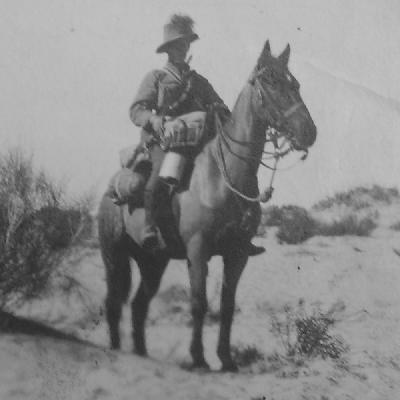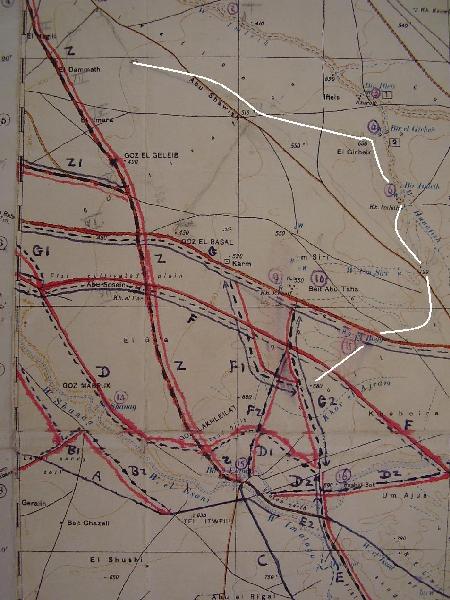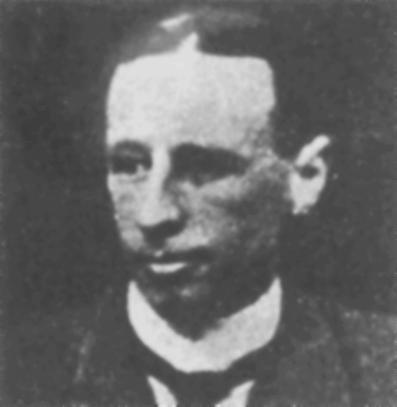The identity of GGA is possibly Gerald Gleeson Ayliffe who had been a trooper in the South Australian Mounted Rifles, Active No.1 Squadron where he rose through the ranks. Ayliffe was given a commission with the 5th South Australian Imperial Bushmen, 28 February 1901. He served in South Africa till the end of the war. Ayliffe remained with the Light Horse retaining the Honorary Rank of Lieutenant. The essay encapsulates his experience in South Africa.
, January 1914, pp. 135 - 140.
The Bayonet for Mounted Riflemen
In dealing with this question it is important first to come to a clear understanding; as to what we mean by a mounted rifleman. The question of mounted rifle tactics is here dealt with on the distinct understanding that a mounted rifleman is a good horseman and horse master, equal to the cavalryman in these respects, and that he fights on foot and not mounted. He is not a cavalryman, as we understand the word, and he is not a mounted infantryman.
As regards his action when mounted, the question of fire from the saddle was discussed at Bloemfontein in 11912 between Boer and British officers; it was suggested as an occasional method to meet special conditions, rather than put forward as a tactical practice. The so-called "mounted rifle charge," by which occasional success has been attained, was shown as a rule to have been a rapid gallop for a fire position close to an enemy taken unawares, especially in the cases where success was achieved. After peace trials in South Africa the bayonet was proved quite unsuitable as a weapon for use when mounted.
In this article it is proposed to consider the question whether the mounted rifleman should be armed with the bayonet, for use on foot only, and the conclusions arrived at are based upon the discussions at Bloemfontein referred to above.
Partly in order to encourage the offensive spirit, and partly to make full use of the moral and material effects which are produced by cold steel, the cavalryman is armed with the sword or lance, the infantryman with the bayonet. The cavalryman makes full use of the momentum of his horse, is taught to press home his attack mounted, and is armed with an arme blanche suitable for this purpose and for no other. The infantryman is taught to get to close grips with his enemy on foot, and is equipped accordingly. Mounted riflemen-those of them at all events who are trained on a citizen basis, and only for short annual periods-are not taught mounted shock tactics, nor are their horses trained for the purpose, or suited to such training. The question arises whether they should be- taught ever to press their attacks h(-me on foot and use the bayonet as infantry are taught to do.
Let us consider first the essential tactical difference between the two arm, that do their fighting on foot, the mounted rifleman and the infantryman. This difference is due to the greater mobility of the former, which he owes entirely to his horse. To retain this mobility it is essential that his horse shall be readily available for his use when he requires it. To fulfil this condition the horses must usually be mobile, especially in the attack, and for this to be the case it is necessary to have one horse holder out of every four mounted riflemen. For a given strength, in these circumstances, 25 per cent of fire effect is lost with mounted riflemen, as compared with infantry. A commander of mounted riflemen, if he wants to obtain the full effect of his arm, must use its mobility to its full extent, and he mast think constantly, not only of the positions of his men, but also of the positions of his led horses.
In view of the fact that full tactical use can only be made of this mobility where freedom to manoeuvre is unfettered, it will be as well to consider our question under two definite headings
I. - Freedom of manoeuvre unlimited.
II. - Freedom of manoeuvre limited for one side or the other, either by the nature of the country, or by the mission which the force is required to carry out.
I. - Freedom of Manoeuvre Unlimited.
(a) In the Attack.
In the attack by daylight we see at once how difficult it is for mounted riflemen, who are advancing on foot, to have their horses constantly close to them. Masses of horses afford a large and conspicuous target for guns and rifles, cover for them is difficult to find, and this difficulty increases as the defended position is approached. The defenders, on the other hand, can usually have their horses under cover not far front the firing line. For these reasons it seems highly improbable that mounted riflemen, advancing for long distances on foot, will have much chance of getting home with the bayonet against well handled enemies in a defensive position. Rather than await such attack, it would be open for the defenders to mount rapidly, make use of the superior mobility thus assured, out-manoeuvre the dismounted attackers, and either pour a heavy fire upon them from some fire position or, a flank, or shoot down their horses and so destroy their mobility once for all.
The foregoing remarks apply to attacks in daylight by mounted riflemen upon mounted riflemen, and not upon infantry. Infantry, on account of their inferior mobility, cannot occupy as extended a front in proportion to their numbers as can mounted riflemen. It is open to the latter either to manoeuvre the infantry out of their position by seizing fire positions on their flank, or, if no such positions are available, to outflank the infantry and even to surround them. With plenty of time available, a force of mounted riflemen adopting these surrounding tactics has practically a certainty of defeating, in a country like South Africa at all events, a slightly inferior force of infantry. They kill, moreover, be able to do so with a minimum of loss to themselves, and they will not require the bayonet for the purpose. On the other hand, if time is limited owing to the defenders expecting reinforcements from elsewhere, or for other reasons, a superior force of mounted riflemen, which does not succeed in ousting infantry from a position by manoeuvre and fire action alone, must then fight as infantry fight, and be taught, as infantry are taught, to get home with the bayonet. With good troops on both sides the attackers will require greatly superior numbers for the purpose. When the full use has been made of the horses to enable the mounted riflemen to deliver their attack from the most effective direction, then it is improbable that further use can be made, in this instance, of superior mobility. As the horses need no longer be mobile, most of the horseholders can be in the firing line. Unless they go there, the mounted riflemen will lose 25 per cent of fire effect and of impetus for their bayonet charge.
For night attacks the bayonet should be of use in all cases. Owing to restricted view the fire of the defenders cannot be as effective as by day, so the approach mounted can be closer. Surprise, as we all know, is a dominating factor, and the silence and secrecy of the bayonet in skilled hands makes it above all others the most effective weapon to employ. Furthermore, its use, as compared with rifle fire minimizes the chances of killing friends instead of foes.
(b) In the Defence.
We can now consider the use of the bayonet by mounted riflemen who are, for same purpose or other, occupying a defensive position-freedom of manoeuvre being complete for both sides. In such circumstances, when considering the attack, we saw that, in most cases, the defending mounted riflemen could operate most effectively by waiting until the attackers had lost mobility by leaving their horses at a distance, and then mount under cover and make full use of their own mobility to out-manoeuvre their opponents.
Should this course be impossible for some reason or other, and should the attackers succeed in creeping so close that the defenders are unable to get to their horses, then again we find a use for the bayonet by mounted riflemen. A bayonet charge by the defenders may be the most effective, or even the only way to save the situation, This subject will be treated at greater length when considering the case where freedom to manoeuvre is limited for one or both sides.
As regards defence of a position by night, the defenders will be especially anxious to prevent rather than to ensure, secrecy regarding the development of an attack. The free use of rifle fire will, therefore, be less open to objection, and the bayonet perhaps less important for this reason. At the same time, the advantage of being better able to distinguish friend from foe when using this weapon holds good in this as in the former case.
II. - Freedom of Manoeuvre Limited.
Before proceeding farther, it seems desirable again to impress the point that, so far, we have only been considering the tactics of the mounted rifleman whose, freedom of manoeuvre is unlimited. We had an example of this in the case of the Boer forces in some of the phases of the South African War. They could rove at will over wide and sparsely populated country, giving or refusing battle at their will, and making full use of their mobility to arrange sudden combinations, and to strike sudden and unexpected blows. They were good horsemen who had spent their lives in the saddle, and good individual rifle shots. It was under these conditions that armed with the rifle only, they made their world-wide reputation. But even in that war it was not on all occasions that freedom of manoeuvre was complete. The forces investing Ladysmith, for instance, were tiled to the vicinity of that place when attacked by the British relieving forces, and it is not difficult to imagine somewhat similar cases in which one side or the other will be unable to manoeuvre at will in wars fought in other countries, and wen in South Africa itself.
A force of mounted riflemen may have its movements limited by the fact that it is only a comparatively small portion of a very large force which shuts it in on both flanks. The mission of mounted riflemen may be to press forward and interfere with mobilization, demolish bridges or other facilities for movement of troops and stores, and so forth. Such objectives may be guarded by small bodies of infantry, or even of mounted troops, who are obliged to stand their ground n order to carry out their mission. It is not difficult to conceive a number of similar examples of cases in war in which mounted riflemen - defined as “good horsemen, armed with rifles, who fight on foot" - would find that their freedom of manoeuvre was limited. In fact, it would hardly be going too far to say that such conditions represent the average, rather than the exceptional, case in war generally.
We now come to the question whether, in such circumstances, mounted riflemen require rifles only, or whether they should have bayonets and be carefully trained in their use.
(a) In the Attack.
Let us again consider the attack first. In discussions with some of our most distinguished opponents in the late war, the point has frequently been made that, by creeping under cover to close range, bodies of Boers on some occasions succeeded, using rifle fire alone, in driving good infantry out of defended positions. They did this by skilful use of cover, creeping up to within few yards, and picking off every defender who showed his head to fire. As these examples provide a very strong argument in favour of equipping mounted riflemen with the bayonet for use when acting on the defensive, it is not necessary to answer the point at this stage; it will be referred to later. In considering the attack generally, it seems sufficient to note that, when mounted riflemen are fighting under conditions which prevent the tactical application of their superior mobility, then they have lost the factor--mobility-which distinguishes them from infantry. They must fight as infantry fight. Wide experience, drawn not from one; special example, but from wars over all parts of the world, has taught the lesson that infantry require bayonets as well as rifles, and if this is the case then mounted riflemen, fighting as infantry, require the same amount when pressing home an attack.
(b) In the Defence
Turning now to the question of the defensive, with freedom of manoeuvre limited, we can adopt the same argument. Our tactical instructions for infantry impress, as strongly as anything can be impressed, the importance of the use of the bayonet by defenders of a position, both as a means of meeting assaulting troops, and as a means of carrying out local counter-attacks to force an enemy to throw his reserves into his firing line.
But let us consider at greater length the examples, referred to above, where Boer mounted riflemen succeeded, by rifle fire alone, in wresting positions from good infantry. On investigating these cases, it will be found that positions so captured were most of them on the skyline of steep, rocky hills or kopjes. Such positions are, of course, very weak ones, because they do not provide a good field of fire. They afford a view of the low ground a few hundred yards away, but no view at all of the steep, rocky slope immediately at the defenders' feet. Attackers who succeed in reaching the foot of such steep slopes are practically safe from rifle fire, unless flanking fire can be provided, which is seldom possible. Such attackers can creep up to very close range, even within 8 or 10 yards, and then be concealed and wait till a defender's head shows on the skyline. The result is obvious. The defender has to peer about for some time for his enemy, who spots him at once and shoots first. But what is the solution from the defender's point of view? There seems to be only one alternative to “Hands up," and that is to form behind the skyline, charge over it, and hurl the attackers down the slope, bayoneting those that hesitate about leaving. Numerous examples can be quoted of the success of such tactics. Waggon Hill suffices as a case in point.
It may be advanced that a weak skyline position of this nature should never be held, and that all positions should have a clear and continuous field of fire, extending from the firing line itself for many hundred yards. Desirable as this may be in theory, it is seldom attainable in practice, and although sometimes possible with small forces, it is seldom possible with very large ones. Nearly all extended positions have weak points in them.
Conclusion
With complete freedom to manoeuvre for both sides, it does not seem pi that mounted riflemen will find as much use as infantry do for the beyond forces are not too unwieldy because of their size, then the mobility of m riflemen affords them effective means of dealing with enemies who leave, horses and attempt long advances on foot. On the other hand, even with complete freedom to manoeuvre, uses can be found for the bayonet, especially night.
Where for some reason the power of manoeuvre is limited by the ground, by the situation of neighbouring forces, or by the mission entrusted to the troops, then mounted riflemen must fight as infantry fight, and be armed as infantry are armed.
In deciding upon the armament of mounted troops due regard must be paid to the periods of training undergone by men and horses, and especially also to skill in leadership. The cavalry leader, for instance, may have to make up his mind in the fraction of a second whether shock tactics or fire tactics, or a combination of the two, will be the best method to defeat his enemy. Such leadership requires practice and judgment attainable only by the professional soldier. As regards completeness of armament, we can put at one end of the scale the Russian cavalryman, who receives several years' continuous training as a regular soldier, who:
"carries a rifle slung over the left shoulder, a sword from his right shoulder, a bayonet superimposed on the sword-scabbard, forty-five rounds of ammunition in two pouches at his waist, a steel tube lance if he is a front rank man, and perhaps a light entrenching tool." [The Army Review, April, 1913, page 580]
At the other end of the scale of armament we can put the citizen mounted troops of a Dominion like South Africa, who are nearly all good horsemen and fairly good shots when they join as recruits, but are unable to spare time for more than a very few weeks' training every year. Some of the men of forces of this nature have in the past carried a rifle only. The majority have now recognized the need of a bayonet, both on account of its practical utility, and also on account of its great moral effect.










